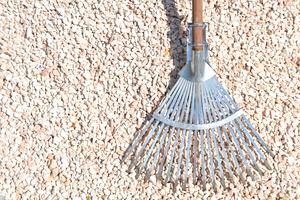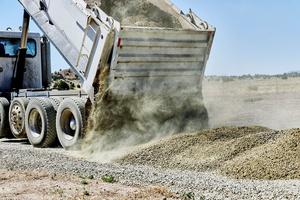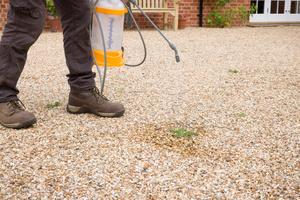Gravel driveways are very popular thanks to their affordability and versatility when it comes to color and style. When you consider their eco-friendly nature and ease of installation, it’s clear why there are so many gravel driveways in front of homes throughout the nation.
However, gravel driveways do need some regular maintenance to ensure they continue performing and looking their best. Whether you already have a gravel driveway or you are considering having one installed, it is important to know what you’ll need to do to keep it in top shape. Here’s a look at the best ways to care for and maintain your gravel driveway.
Rake Your Driveway

One quality many people appreciate in gravel driveways is their permeability. They are made up of small rocks that allow water to flow through easily, which means there is no need to worry about draining issues or flooding. However, debris can build up fairly easily in gravel given its loose nature. Raking it is a great way to filter out this debris; make sure you use a heavy-duty rake that is specifically designed to maintain a gravel driveway.
In addition to helping sift the gravel and filter out debris, raking can help to even the gravel out. You can easily push gravel into bare spots that develop from wind, traffic or rain so it maintains a smoother and more uniform appearance.
Direct Water Away From The Driveway
One of the best ways to maintain your gravel driveway is by forming a crown of gravel at the middle of the driveway to direct water to the sides. This can be accomplished with a rake on smaller driveways or a grader blade on bigger driveways. Aim for a half-inch of crown for every foot of your driveway’s width. For example, if your driveway is 12 feet wide, you should make the gravel reach 6 inches higher in the middle.
Address Areas Of Pooling Immediately
If you notice any low areas in your driveway where water is pooling after rain, add some gravel to those spots. You will need to compact it well, but make sure you keep that area slightly higher than the area surrounding it so that rainfall can run off. Another option is to dig a ditch on the side of the driveway to pull water away from low spots.
Avoid Using Snow Plows
Everyone understands the frustration of needing to get out of your driveway quickly when snow is blocking your path, but you should resist the temptation to use a snow plow on your gravel driveway. In addition to catching snow, plows also catch gravel along the way. This means that after the snow melts, you’ll need to redistribute the gravel, which can be a very time-consuming task.
Spray Dusty Gravel

The small rocks that make up gravel continue to break down over time, and it is not unusual for dust to form that can get kicked up when you drive across it. Rainwater will naturally wash this dust away, but when your area experiences prolonged periods without rainfall, the dust can build up significantly and get your vehicle dirty. Therefore, you will need to spray it down from time to time using a basic garden hose. A light watering is enough to keep the dust weighed down, and it can also loosen clumps of dirt that have become stuck in your driveway.
Compact Your Driveway
It is useful to compact your gravel driveway from time to time. If you have a roller attachment, this will do the job efficiently. However, you can also compact it by driving over it numerous times in a heavy vehicle.
Fix Potholes With A Compactor
Although raking can be very effective when it comes to fixing bare spots, it won’t do much to improve potholes in gravel driveways. Instead, you will need to reapply a small amount of gravel to the pothole and then compact it using a heavy roller, or it will keep reappearing in your driveway. It is best to fix potholes as they happen instead of letting them snowball into an even bigger pothole that will be more challenging to repair.
Grade Your Driveway
You will need to grade your gravel driveway once or twice per year. This can be done using a grader blade attachment on a tractor if your driveway is large. Simply work the gravel on the surface to ensure it provides effective drainage away from the house.
Use Pavers To Stabilize It
Loose gravel can also be stabilized with pavers. These are laid across the gravel and can lock it into place, keeping it level and stable with very little maintenance needed.
Keep Weeds Away

You can keep weeds and plants from growing in your gravel driveway by spraying a non-toxic herbicide across the top of it with a garden sprayer. You can even make your own non-toxic herbicide by mixing a gallon of white vinegar with a cup of salt and a tablespoon of the liquid dish soap of your choice. Simply apply it as needed as part of your driveway maintenance routine.
If you are laying a new top layer of gravel on an older driveway, you can take advantage of the opportunity to add some landscaping fabric underneath it. The fabric can be easily cut to fit the dimensions of your driveway and will keep weeds and grass from growing beneath your gravel and stone and pushing up through the driveway. This is an affordable solution that is very easy to do yourself.
Drive Slowly
One great tip for reducing the amount of maintenance your driveway needs is to drive on it slowly. This helps keep the gravel from straying too far and often means you won’t need to grade or rake it as often.
Reach Out To Dirt Connections
Gravel driveways can last for a long time with proper maintenance, and they also add to the aesthetics of your home. To find out more about gravel driveway installation, grading, or gravel delivery in the Northern Virginia area, reach out to the residential driveway specialists at Dirt Connections today.
Summary

Dirt Connections was started with one goal in mind: providing quality residential and commercial construction services to clients on time and on budget. Reach out for more information on how we can support your next project.
For your convenience our estimates are free and by appointment. Call 703-940-9949 for a free estimate today!









































